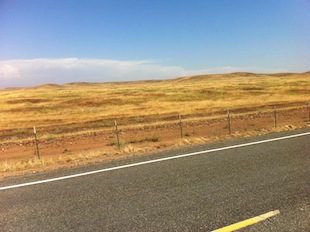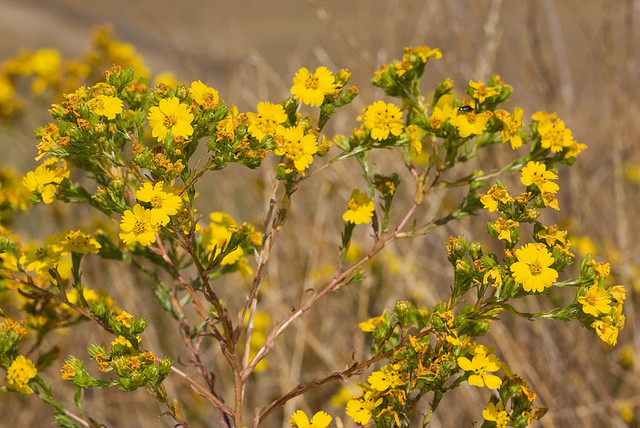Indeed, seasonal changes are always subtle here in the San Joaquin Valley; one must attend closely to the landscape to see them. But one ubiquitous reward for such vision is that, beginning around the middle of August, flourishes of colorful clustered tarweed (Deinandra fasciculata, part of the daisy family) and yellowflower tarweed (Holocarpha virgata, a member of the sunflower family) spangle the fields in bursts of yellow and green, and herald the advent of autumn.
Tarweed blooms just when th e odds of anything colorful appearing in our pastures seem longest. It’s a “pioneer species” in the truest sense: It’s eminently hardy, to the extent that it colonizes disrupted or damaged ecosystems that bear the stamp of changes in land use or that of prolonged drought. It achieves this by working throughout the year to establish itself—particularly by developing a deep taproot in winter, sprouting a characteristically sticky (hence its name) rosette of branches in spring, and capitalizing on surpluses of water in the soil early in the growing season so as to outcompete neighboring plant life.
e odds of anything colorful appearing in our pastures seem longest. It’s a “pioneer species” in the truest sense: It’s eminently hardy, to the extent that it colonizes disrupted or damaged ecosystems that bear the stamp of changes in land use or that of prolonged drought. It achieves this by working throughout the year to establish itself—particularly by developing a deep taproot in winter, sprouting a characteristically sticky (hence its name) rosette of branches in spring, and capitalizing on surpluses of water in the soil early in the growing season so as to outcompete neighboring plant life.
Although it is associated with dynamic conditions, tarweed is non-invasive, as it is indeed native to the American southwest. There are plenty of other species that look like tarweed but are indeed invasive, having come from Europe and Asia along with the livestock that now populate our expansive San Joaquin Valley meadows. Native tarweed can also pose a threat to grasses and  wildflowers it is in the process of crowding out, despite providing an important reservoir for water in our parched soil.
wildflowers it is in the process of crowding out, despite providing an important reservoir for water in our parched soil.
As it colorfully marks the time, tarweed points up the environmental legacies of the past century, particularly the enhanced agricultural imperatives that have transformed the California landscape. In some ways, tarweed can be thought of as a reminder of what we’ve lost, a vibrant swell of green and yellow in fields undergoing subtle changes (such that their vitality may seem an afterthought).
At the same time, insofar as the ubiquity of tarweed also portends natural successions toward more biodiverse ecosystems, it may also be a sign of hope. Buoyed by its presence, our local landscapes may be “healing”—returning to states more amenable to biodiversity, and/or growing to new ecological balances comparably facilitative of biodiversity.
When you’re idly gazing out your car window—or, better, scanning the landscape from the seat of your bicycle—keep an eye out for tarweed. It is a welcome burst of color as well as an embodiment of change in the Valley landscape.


